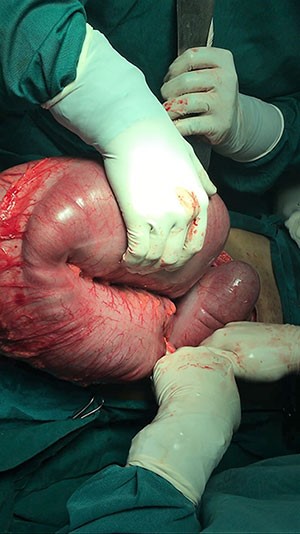Abstract
Background
Patients with von Hippel-Lindau (VHL) disease may have concurrent pathologic abnormalities within the pancreas that may complicate management and surgical decision-making.
Summary
A 56-year-old patient with VHL had developed multiple cystic lesions in the pancreas, but was asymptomatic. A fine needle aspiration (FNA) of a dominant cyst in the body of the pancreas was KRAS was positive, but all other evaluations were unremarkable. The patient was asymptomatic and, after counseling, chose to continue close monitoring. Imaging with ultrasound or MRI was performed every six months for surveillance. No significant changes were noted until an asymptomatic 3 cm mass developed in the pancreas head. A total pancreatectomy was performed.
Conclusion
Pancreatic involvement is common in patients with VHL and is typically benign; however, malignancy can occur, so careful follow-up and, when indicated, assessment with FNA is mandatory. Total pancreatectomy should be considered if pathology involves the entire pancreas.
Key Words
Total pancreatectomy, von Hippel-Lindau, K-RAS, microcystic adenoma
Case Description
Von Hippel-Lindau (VHL) disease is a rare, hereditary cancer syndrome caused by mutations of the VHL tumor suppressor gene, leading to continuous expression of angiogenic and growth factors.1 The incidence of VHL disease is one in 36,000 live births in the United States, with a mean age at diagnosis of 26 years and more than 90 percent penetrance by the age of 65.2–5
Patients with VHL have an increased risk of developing multi-organ neoplasms. The most common tumor in VHL patients is CNS hemangioblastoma, which affects 70 percent of patients and presents at an average age of 33 years.1,2,6–8 Retinal angiomas are also common, presenting at an average age of 25 years in 60 percent of patients.3 Benign renal cysts, renal cell carcinoma, and pheochromocytomas are also frequently diagnosed.8 Approximately 60–77 percent of patients with VHL have pancreatic involvement, most often cystadenoma (17–56 percent), neuroendocrine tumor (NET, 10–17 percent), or both in 11.5 percent.9–15 Cystic pancreatic lesions tend to be the least symptomatic of VHL neoplasms, and cystadenomas may with increasing size compress neighboring organs. Cystadenomas are considered benign, but do have an ill-defined risk of malignancy (cystadenocarcinoma). NETs may have malignant potential and 25–50 percent have metastasized at the time of diagnosis.10,13,16–21
In this paper, we discuss the management considerations of a patient with VHL who had radiographic abnormalities throughout her pancreas. The patient ultimately underwent a total pancreatectomy after careful consideration of all surgical and follow-up options.
A 56-year-old woman was referred to the pancreas multidisciplinary team for evaluation of multiple pancreas lesions. The patient was initially diagnosed with VHL when she was in her twenties. At age 40, she had a spinal hemangioblastoma removed. On subsequent follow-up imaging, she was noted to have lesions developing in both kidneys and her pancreas. She developed renal cell carcinoma (RCC) and underwent a partial right nephrectomy at age 44. At the time of her partial nephrectomy, several cysts were noted in the pancreas, but none were more than 2 cm in diameter and did not have features worrisome for malignancy.
Over time, imaging of her pancreas revealed an increasing number of cystic lesions. At age 50 (six year prior to being referred to our clinic), an endoscopic ultrasound (EUS) with fine needle aspiration (FNA) of a dominant cyst in the body of the pancreas was sampled. KRAS was positive, but all other evaluations were unremarkable. At that time, a new lesion was noted in the left kidney. She underwent total left nephrectomy.
Following the left nephrectomy, the patient was asymptomatic—without abdominal pain or other symptoms of pancreas disease. The patient and her doctors chose to continue close monitoring with ultrasound or MRI imaging performed every six months for surveillance. No significant changes were noted until age 55, when an asymptomatic mass was first noted in the pancreas head. During the next 18 months this mass increased in size to 3 cm and she was referred to us (Figure 1).





